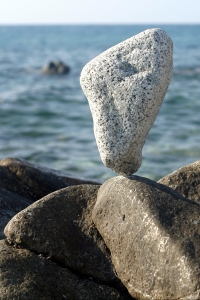
by Ann Betz
At BEabove Leadership, we have learned that the prefrontal cortex (PFC) needs just the right amount of stress/stimulation to function optimally. Too little excitement, challenge, purpose, etc., and the chemical balance skews, too much stress, pressure,
or demands, and the same result. (For more on the mechanics of this phenomenon,
see here.)
purpose, etc., and the chemical balance skews, too much stress, pressure,
or demands, and the same result. (For more on the mechanics of this phenomenon,
see here.)
For me, this understanding had a huge impact on my life, and I have begun to see that managing my PFC needs to be part of a basic human maintenance plan, just like keeping gas and oil in my car and not overheating the engine. This isn’t particularly easy for anyone in today’s world, and I personally struggle with a demanding international travel schedule and the challenges of co-owning an-ever developing business. But I realized one day recently that I have some rules which seem to work for me that I thought might be helpful to share.
I want to note that everyone’s balance curve is different though—what might be stressful to me could be stimulating for you, and vice versa. Ultimately, we each have to figure out our own “just right.”
Ann’s stress decrease rules:
- No work on the airplane. I find travel stimulating enough, thank you. It’s a lot of sensory information coming at me, and add to that any uncertainty inherent to a new
location, especially a new country, and I am full, if not overloaded. So my personal rule is that I don’t generally work when I travel. I read, cocoon myself in headphones, nap. I have told my inner
entrepreneur gremlin that my travel days are work, thank you very much, and I don’t really want to do more that just be. I don’t want to log onto email and make decisions in
addition to the ones I have to make to just get to my destination.
- I get a day off. The day after training and travel is ALWAYS an off day. This is re-entry for me, and it is a hard line to keep, but I have gotten better and better at it.
It’s hard because I travel a lot and have clients and meetings always looking for a place to slot in. But I have begun to see that time has a way of flowing into whatever boundaries I make, and the
more I honor myself and my needs, the more I have to give.
- Whenever possible, nothing work-related with humans before 9 am or after 4 pm. I’m just not good early in the am, and by 4 pm or so, I’m usually feeling done talking to
people. Now that I live in Santa Fe, New Mexico, which is two hours behind the East Coast, this can also be a challenging line to hold. I do make an exception for one beloved client in China and also
to teach an occasional evening teleclass (also to make things work time-wise for our students in China). But again, the more I honor my own needs, the more I am finding that somehow it works out
despite the occasional urgency of others.
- Stay home in the evening after an intense day. I rarely go out in the evening when I am training. This is a hard-learned lesson, because I have both introverted and
extraverted tendencies, and my inner extravert always thinks that doing something in the evening after a training day Will Be Just Fine. But too often, I’ve regretted the extra stimulation, even if
it is fun at the time, so I have learned to keep a low profile when I’m in the middle of multiple day training session. There are exceptions to this (nothing is black and white), for example, see
rule #10 below.
- Stop, Drop and Roll. I give myself permission to recalibrate. If I get home from traveling (or have simply been juggling a lot of balls) and start feeling like wow, there is
a lot to do (there is ALWAYS a lot to do when you own your own business) but I can’t really focus effectively, I know my job is to simply stop, drop and roll. Stop the thoughts
that I should be productive, Drop my complicated plans and pressures, and Roll with what I want in each moment, even if that is staring numbly at the TV for an
evening while I pet the cat. I often ask myself, will the thing I have planned or feel I need to do right now add to the stress in my life? And if so, what is my current capacity for that?
- Manage my health. I pay very close attention to food, sleep, and exercise. I bring healthy food with me when I travel and stay in places where I can cook rather than eat
out. I also bring my lunch to the training room so that break time is less frantic and I can recalibrate a bit during the day. I also know that getting a good night’s sleep is critical to managing
stress and stimulation during the day, so we generally start our trainings at 9:30 a.m, stay as close to the venue as possible, and go to bed early. Exercise is the one that often escapes me, even
though I know it is one of the best ways to manage stress, but I try to get myself out in the evening for a bit of a walk, even if I don’t make it to an optimal 10,000 steps for the day.
Ann’s stimulation increase rules:
- Do what’s fun, joyful, meaningful and related to my life purpose. I try my best to continually evaluate my joy and resonance when I get a new opportunity, asking, will this
be fun? Will it be interesting? Will it grow me? Or is it just a money-making or strategic thing (and sometimes I do take those—I still have a kid in college), but my preference is that sweet
intersection where the project is rewarding on all levels, including financially.
- Keep it interesting and novel. More and more, I try not to do things that aren’t interesting. This gets harder the more experienced I become in my craft of teaching and
speaking, because what once was challenging can become life as usual. Luckily my beloved business partner gets bored easily as well, and is always up for trying out a new program, webinar, or radio
show. And the more we don’t know about a subject, the more interested we are in finding out – and then sharing with others.
- Challenge myself to do things I am not good at. This is very much related to rule #8, in that these are often new things. For example, I am studying painting and often I
kind of suck. I took a class recently where we were painting on large panels and I challenged myself to keep destroying what I had made unless I truly loved it. My piece got worse and worse and
worse. By the end, it was simply horrible. My teacher I think felt bad that I didn’t have something to take home that I liked. But I loved the whole mess of it. The frustration, the failure, watching
something not work and staying with it, and feeling that my vision far exceeded my capacity. It was a wonderful irritating blast.
- Stay connected to the humans I love. Sometimes this means breaking rule #4 (stay home in the evening after training) when I am traveling and there is an opportunity to see
an old friend, but this is about balance and managing both stress and resonance. I try to pay close attention to whether going out will be life-giving or draining, and spend time with those people
who add to my joy and delight while limiting exposure to those who drain and sap my energy.

Integration: The Power of Being Co-Active in Work and Life
by Ann Betz and Karen Kimsey-House
Integration examines how we came to be polarized in our dealing with self and other, and what we can do to move from an either/or state to a more effective and fulfilling way of being.
Buy this Paperback £12.99 / $20.95: AMAZON US | AMAZON UK | BARNES & NOBLE
Categories:
0 comments on this article







